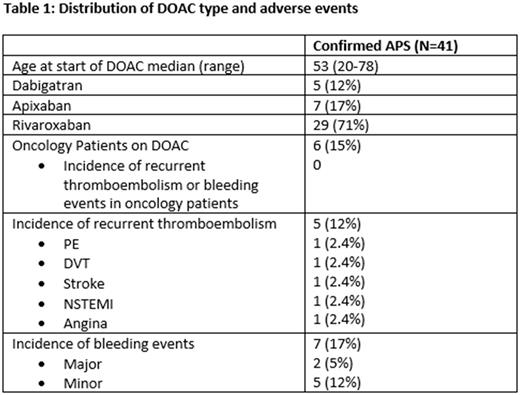Abstract
BACKGROUND: Anti-phospholipid antibody syndrome (APS) is an autoimmune thrombophilic syndrome characterized by venous and arterial thromboembolic disease (TED) in the presence of anti-phospholipid antibodies. Treatment requires anticoagulation, though the optimal choice for anticoagulant is not clear. Warfarin is the most common agent these patients are started on but it requires frequent INR monitoring and has many drug and dietary restrictions. The use of direct oral anticoagulants (DOACs) in this setting is an attractive option but has not been well studied. DOACS include apixaban, dabigatran, edoxaban, and rivaroxaban and have been approved in the treatment of venous thromboembolism but not in APS.
METHODS: We sought to identify patients with antiphospholipid syndrome who have been treated with DOACs through a retrospective cohort analysis. Our objectives were to measure the incidence of recurrent TED, bleeding rates or other complications from the DOAC treatment. We used an institutional patient database at a single center to find patients on DOACs who were tested for antiphospholipid antibodies (lupus anticoagulant or Russell venom viper time, anti-cardiolipin antibody, and beta-2 glycoprotein-1 antibody) and fulfill the Revised Sapporo criteria regarding thrombosis, pregnancy complications, and laboratory evidence. Chart reviews were conducted to find bleeding and clotting complications, in addition to any other complications that led to changes in their management.
RESULTS: Three hundred and sixty seven patients on DOACs were tested for antiphospholipid antibodies. One hundred and seventy of these had positive antiphospholipid testing. However, only 41 patients' positive tests were confirmed after a 12-week window per Sapporo diagnostic criteria. Most common DOAC used was rivaroxaban (29/41, 71%; see table 1). Within these 41 patients with confirmed APS, 5 (12%) had recurrent TED events (see table 1). Three of the patients who had recurrent TED were non-compliant with anticoagulation. These included 1 PE,1 DVT and 1 stroke patient. Two of those patients continued with a DOAC and did well since being compliant. The third patient had both thrombosis and hemorrhage of unclear etiology, so was not restarted on any anticoagulation. Two patients (5%) experienced major bleeding and 5 (12%) minor bleeding. Regarding the two major bleeds, one patient had a gastrointestinal bleed nearly 1 year after starting a DOAC and the second patient had a retroperitoneal bleed 2 months after starting. The second patient was treated with 4-factor activated prothrombin complex concentrate, which was complicated by a stroke. No patients died from any of the adverse events. Fourteen patients (34%) started on DOACs as the first line regimen while the rest had been previously treated with another anticoagulant. Reasons for switching to DOAC were mostly because of difficulty managing INR's with warfarin in 11 patients (27%). Thirty-two patients (78%) are still on a DOAC. For these 32 patients, safe and effective anticoagulation with a DOAC is noted for a median of 48 months (range 14-62 months).
CONCLUSION: In this study, rates of recurrent TED and bleeding complications were shown to be similar to previously published studies using warfarin in APS. DOACs appear to be a safe and effective treatment option for APS. However larger prospective studies are needed for DOACs to be routinely considered.
No relevant conflicts of interest to declare.
Author notes
Asterisk with author names denotes non-ASH members.


This feature is available to Subscribers Only
Sign In or Create an Account Close Modal